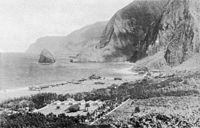- Hydnocarpus wightiana
-
Chaulmoogra Scientific classification Kingdom: Plantae (unranked): Angiosperms (unranked): Eudicots (unranked): Rosids Order: Malpighiales Family: Achariaceae Genus: Hydnocarpus Species: H. wightiana Binomial name Hydnocarpus wightiana
Blume[1]Hydnocarpus wightiana or Chaulmoogra is a tree in the Achariaceae family. The oil from its seeds has been widely used in Indian medicine and Chinese traditional medicine for the treatment of leprosy. It entered early Western medicine in the ninteenth century before the era of sulfones and antibiotics for the treatment of several skin diseases and leprosy[2]. The oil was prescribed for Leprosy as a mixture suspended in gum or as an emulsion.[3][4]
Physical chararecteristics and composition
The oil is semi-solid at room temperature and does not have a strong odour. Gas-liquid chromatography analysis has shown the oil to contain the following fatty acids - hydnocarpic acid, chaulmoogric acid, gorlic acid, lower cyclic homologues, myristic acid, palmitic acid, stearic acid, palmitoleic acid, oleic acid, linoleic acid and linolenic acid.[5]
Medical use
The active ingredient that produces antimicrobial activity has been indentified as hydnocarpic acid, a lipophilic compound. It acts by being an antagonist of biotin.[6] The oil was used intravenously or intramuscularly in the early part of the twentiety century against leprosy. An ethyl ester of the oil was prepared by Burroughs Wellcome and marketed in the early 1920s. This was also used intravenously for leprosy patients often producing local reactions. The oil was also often obtained directly from India by several doctors in Africa, such as the Great Rift valley. The doctors would locally prepare ethyl esters to treat their patients. In June 1927, Burroughs Wellcome released the commercial preparation, sodium hydnocarate marketed as Alepol, which produced lesser disagreeable symptoms of pain, swelling, irritating cough and blocking of the veins. In May 1928, doctors reported cure of leprosy in some patients after treatment with alepol [7]
The oil contains 5′-methoxyhydnocarpin an amphipathic weak acid[8] . Although a minor component in the oil with no antimicrobial activitiy on its own, it plays a role in preventing multidrug resistance among some bacteria such as Staphylococcus aureus. It potentiates the action of berberine by preventing its removal from within bacteria thus leading to accumulation of berberine in the cells. Several berberis medicinal plants producing berberine also synthesize an inhibitor of the multidrug resistance pump of a human pathogen Staphylococcus aureus. Berberine alkaloids, which are cationic antimicrobials produced by a variety of plants, are readily extruded by multidrug resistance pumps. They are constituents of several native american traditional medicine preparations.[9] By extracting and using hydnocarpic acid only, western medicine could not utilise the action of the other ingredients of the oil which have been now shown to have synergistic antimicrobial activity.[9]
In view of its anti-mycobacterial activity, it has also been tried on other conditions caused by mycobacteria such as tuberculous laryngitis.[10]
References
- ^ Rumphia 4: 22. 1849. See IPNI [late Oct 1849]
- ^ Norton, SA (1994 Oct). "Useful plants of dermatology. I. Hydnocarpus and chaulmoogra.". Journal of the American Academy of Dermatology 31 (4): 683-6. PMID 8089304.
- ^ Cottle, Wyndham (June 28, 1879). . "Chaulmoogra Oil in Leprosy". The British Medical Journal 1 (965): 968–969. doi:10.1136/bmj.1.965.968. http://www.jstor.org/stable/25251370 .. Retrieved 19 January 2011.
- ^ Parascandola, J (2003). "Chaulmoogra oil and the treatment of leprosy.". Pharmacy in history 45 (2): 47-57. PMID 12894769. http://citeseerx.ist.psu.edu/viewdoc/download?doi=10.1.1.2.164&rep=rep1&type=pdf. Retrieved 22 October 2011.
- ^ Sengupta, A.; Gupta, J. K., Dutta, J., Ghosh, A. (1 June 1973). "The component fatty acids of chaulmoogra oil". Journal of the Science of Food and Agriculture 24 (6): 669–674. doi:10.1002/jsfa.2740240606.
- ^ Jacobsen, PL; Levy, L (1973 Mar). "Mechanism by which hydnocarpic acid inhibits mycobacterial multiplication.". Antimicrobial agents and chemotherapy 3 (3): 373-9. PMID 4799554.
- ^ Simpkin, Alice (December 1928). "The Treatment of Leprosy". British Journal of Nursing: 313-4. http://www.leprosyhistory.org/cgi-bin/showdetails.pl?ID=437&type=lep. Retrieved 22 October 2011.
- ^ Ranganathan, KR; Seshadri T R (1974). Indian Journal of Chemistry 12: 993.
- ^ a b Stermitz, F. R. (3 February 2000). "Synergy in a medicinal plant: Antimicrobial action of berberine potentiated by 5'-methoxyhydnocarpin, a multidrug pump inhibitor". Proceedings of the National Academy of Sciences 97 (4): 1433–1437. doi:10.1073/pnas.030540597.
- ^ Lukens, RM (1922). "CHAULMOOGRA OIL IN THE TREATMENT OF TUBERCULOUS LARYNGITIS". JAMA 78 (4): 274-275. doi:10.1001/jama.1922.02640570018009. http://jama.ama-assn.org/content/78/4/274.short.
Categories:- Hydnocarpus
- Ayurvedic medicaments
- Vegetable oils
Wikimedia Foundation. 2010.

